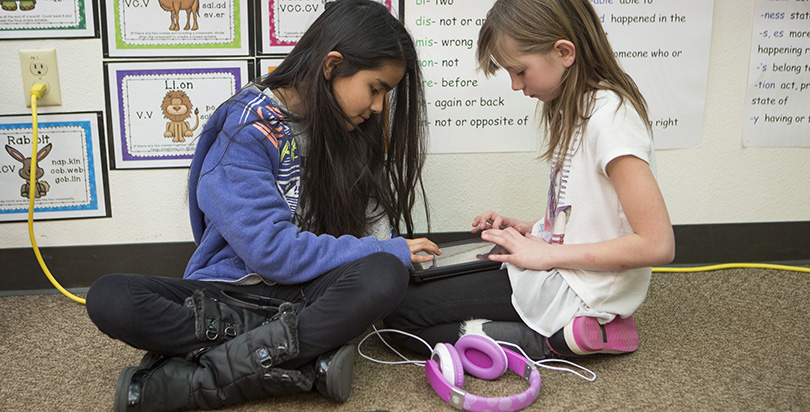Fisher: Making Equity a First Principle of the Personalized-Learning Era

“Racism and inequity are products of design. They can be redesigned.”
These words echoed from the keynote speakers at the annual Blended and Personalized Learning Conference (BPLC) in Providence, R.I., last weekend.
On April 1, in partnership with Highlander Institute and The Learning Accelerator, the Christensen Institute co-hosted the BPLC for the second year in a row. To build the agenda, we used our Blended Learning Universe to recruit innovative school leaders and educators to share their tactics and practices at the cutting edge of school innovation. We also looked for presenters who were wrestling with the challenging gaps in racial and socioeconomic equity that have for too long dominated our education system.
To that end, our keynote address, presented by Caroline Hill, who leads school creation and transformation at CityBridge Education and is founder of the DC Equity Lab, and Michelle Molitor, founder and CEO of Fellowship for Race & Equity in Education (FREE), focused on how we might reframe the conversation about personalized learning to bring equity to the forefront of school and classroom redesign.
As much as we hear “equity” talked about as a value in our education system, it can be difficult to tackle head-on. Since our own inception, the Christensen Institute has been committed to researching and supporting approaches to instruction that break open the factory model of school. We believe that, particularly in light of the growth of online and blended learning, we are living in an era in which we can feasibly redesign school around students’ needs and strengths and free up teachers to teach individual and small groups of students more often.
We don’t research these trends just because they are innovative — but also because they are imperative.
Today, energy surrounding personalized learning is at an all-time high. But this momentum is building against a backdrop that is anything but settled: Stubborn gaps in access, opportunity, and achievement persist. Still only 37 percent of young people graduate ready for college-level work, and only a staggering 10 percent of low-income students make it through college. And these long-standing divisions continue to fall disproportionately along racial lines.

If we take these gaps seriously, school redesign can’t be pursued just for the sake of trying something new. Rather, we need to double down on redesigning the experiences of students in order to re-engineer the unequal results that schools currently produce.
This, of course, is not a new proposition. Many have embarked on blended and personalized journeys hoping to break through persistent achievement gaps. In fact, for a long time in my own speaking and writing I would make this leap: “If we can customize instruction, we will make strides toward closing achievement gaps and get closer to an equitable education system.”
It can be tempting for many in the space to talk about equity as a by-product or outcome of personalized and blended learning; to assume that by using new instructional strategies or simply buying new tools, the results we will get will magically be more equitable. But we live in an era when we need to push on that assumption. First, we need to put a stake in the ground that equity does not just “happen” because of new approaches or good intentions. If we want blended and personalized classrooms to produce more equitable results, then equity has to be a first principle of this work—not a just a hope, at best, or an afterthought, at worst. Second, we need to acknowledge that blended and personalized learning programs alone can, in some cases, yield models that digitize or replicate our old system — perhaps lending it crucial efficiencies and marginal gains — but fail to fundamentally reinvent our designs from the ground up.
Enter our keynote speakers at this year’s conference: Hill and Molitor — both former educators and school leaders themselves — have teamed up with design expert Christine Ortiz to found the Equity Design Collaborative. To launch this project, the three have developed a framework called EquityxDesign. The framework can help school designers (and redesigners) integrate equity as a first principle into blended and personalized learning efforts. Their team is now in the process of designing rigorous toolkits that make putting equity at the forefront of school redesign both feasible and actionable — not an afterthought, but a forethought.
Talking about equity can prove challenging because it confronts both individual beliefs and historical, institutional customs that have become deeply ingrained as habits. Moreover, asking schools to address long-standing gaps can often feel as if we’re piling on yet another task to schools’ already overburdened and cash-strapped plates. But the reality is that in industry after industry we have seen that innovations will scale against the metrics and ambitions we set for them upfront. If we wait on equity, it may never come.
Putting equity first isn’t about doing more for students; rather, it’s about doing differently, to do right by them. Alongside numerous educators and schools at the front lines of this work, Hill, Molitor, and Ortiz are lending the personalized space a language, a framework, and clarity for how to go about doing just that.
Julia Freeland Fisher is the director of education research at the Clayton Christensen Institute. She leads a team that educates policymakers and community leaders on the power of disruptive innovation in the K-12 and higher education spheres through its research. Her team aims to transform monolithic, factory-model education systems into student-centered designs that educate every student successfully and enable each to realize his or her fullest potential.
Get stories like these delivered straight to your inbox. Sign up for The 74 Newsletter

;)